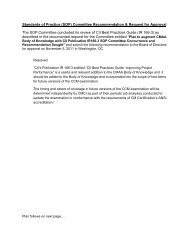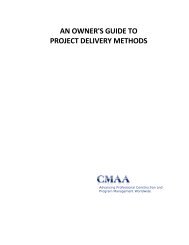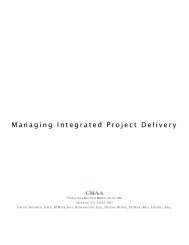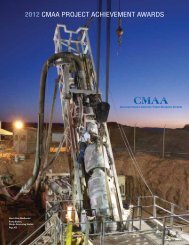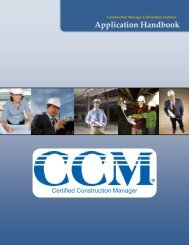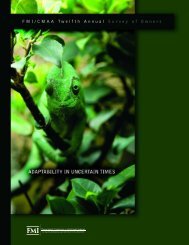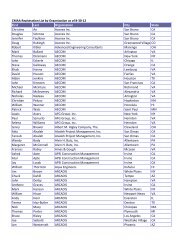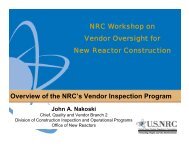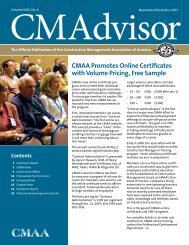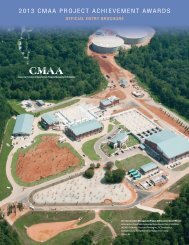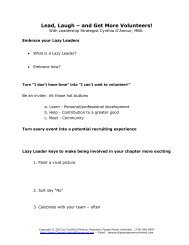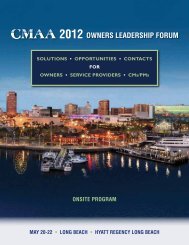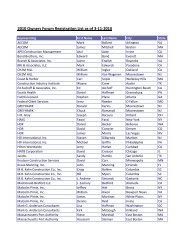Chapter NewsChicago ChapterThe Chicago Chapter announced at its February luncheonthe creation of a new scholarship program for high schoolstudents at the ACE Tech Charter School located in Chicago,Illinois. ACE Tech is the only charter high school in Illinoisthat focuses its curriculum towards architecture, constructionand engineering. It was formed by a group of Chicago’sconstruction industry leaders whose goal was to preparehighly qualified inner-city youths to fill the future growingemployment needs in the construction industry.ACE Tech serves as a model for the next generation of qualityvocational education programs. Students will participate in arigorous curriculum while also being exposed to the technical,managerial, and professional aspects of the constructionindustry. This exposure prepares students to make informeddecisions about their future careers and provides them thelife skills necessary for sustained professional and personalsuccess. More information is available on the School’swebsite at www.acetechnical.org.This new scholarship coincides with the first graduating classfrom the school. In attendance at the meeting were six studentsand two faculty members from ACE Tech High School.Houston ChapterThe <strong>CMAA</strong> Executive Committee chose Houston as the locationfor its February meeting in order to provide leadershipand guidance in promoting the Houston Chapter, discussviable ways to build membership and meet with potentialchapter members. Jacobs Carter Burgess was honored toserve as the host for this meeting. While in town, membersof the <strong>CMAA</strong> Executive Committee met with the City ofHouston’s Public Works and Engineering Construction andEngineering Division, Harris County Infrastructure’s ConstructionDivision and the City of Pearland’s Capitol ProjectsDivision as potential owner members.The <strong>CMAA</strong> Houston Chapter and the City of Pearland’s CapitolProjects Department co-hosted the Webinar presentedby <strong>CMAA</strong> Chairman of the Board Bill Van Wagenen, CCM, onProgram Management in February.Bruce D’Agostino, <strong>CMAA</strong> president & CEO, Hugh Brightwell,chapter president, and Mark Johnson, chapter vice president,met with Joe Myers, president of the Houston Post, todiscuss opportunities to collaborate on programs, education,and mutual support in the Houston and southeast Texasarea. Plans are being made for the <strong>CMAA</strong> Houston Chapterand the SAME Houston Post to co-host the Chapter’s annualClay Shoot-Out in May/June and also to co-host a presentationon Alternate Delivery Methods in June at the monthlySAME Post meeting.Minnesota ChapterOn Feb. 21, the Minnesota Chapter sponsored a seminartitled “Project Management Information Systems in18 CMAdvisor(Left-to-Right) Kevin McCourt (UMN), Mike Perkins (UMN) andBill Breyfogle (MnSCU).Minnesota Higher Education – The Unifier.” One hundred andforty attendees from CM firms, design firms, contractors, andowner organizations gathered in the St. Paul College auditoriumfor continental breakfast, networking, and the program.Two of the speakers represented the University of Minnesota:Mike Perkins, associate vice president, Capital Planning/ProjectManagement, and Kevin McCourt, businessmanager, Design & Construction Services. The third speaker,a member of the chapter’s Board, was Bill Breyfogle, director,Design and Construction for Minnesota State Colleges andUniversities (MnSCU).Together, UMN and MnSCU control two-thirds of all statefacilities in Minnesota. Choices these institutions make inproject delivery have significant impact on the design andconstruction industry for higher education within Minnesota.The UMN and MnSCU have each acquired a license touse a program/project management information softwarefrom the Skire Corporation known as “Unifier” to assist inmanaging their design and construction capital improvementsprogram. Unifier addresses the planning and executionof capital projects and easily adapts to optimize avariety of business processes. Unifier provides software tohelp manage information through every phase of a programor project, from planning and design, through procurement,project execution and into operations and maintenance.The presentation, followed by a question and answer period,was well received and the audience stayed well beyond thescheduled seminar end time.Southern California ChapterThe Southern California Chapter looks forward to its 16thAnnual Awards Banquet on <strong>April</strong> 2. This event has enjoyedcontinued growth and success over the years – the chapterhad to change venues to accommodate this ever-growingattendance. It is expected this year’s event will be attended byover 500 owners, CM practitioners and others who support theConstruction Management Industry in Southern California.The Awards Banquet includes recognition of Project Achievementby the members in a variety of sectors and projectsize. In addition, the chapter honors representatives of localowner agencies who participate in <strong>CMAA</strong> and promote theContinued on page 20
President’s ReportThe Payoff From Changing BehaviorBruce D’Agostino, CAEMark Twain once noted that if a cat sits down on a hot stovelid, he’ll never sit down on a hot lid again. The problem, Twainadded, was that the cat would never sit on a cold one, either.What have stoves and cats got to do with Construction Management?These days, a “once-burned” mindset dominatesthe interactions among participants in a construction project.A typical contract is a thick sheaf of papers nearly all dedicatedto how the parties are going to assign blame and calculatedamages when the project goes awry…which everyoneassumes it will.This orientation was very visible to me when I participated inthe recent Ohio Construction Conference in Columbus, Ohio.To my surprise, one general session turned into an extendeddiscussion of the various model contract documents availabletoday, including ours.With my turn at the microphone, I suggested that rather thancodifying behaviors that assume failure, we should all beworking toward more effective collaboration for the benefitof the project and the owner.This is, of course, easier said than done. We work in an environmentof accelerated scheduled, tight budgets, limited staffresources and higher risk for everyone involved in a projector program. The long-standing relationships that formed thebasis of “agreements” has been replaced by one-time contractsin which risk and reward are evaluated, and expected,on each and every project.A construction job requires the owner, CM, architect/engineer,general contractor, specialty subs and suppliers to work closelytogether. Each, though, has his or her own interests and oftenfeels there’s very little margin for error. It’s easy for a laudablebusiness prudence to evolve into suspicion and opportunism.On the other hand, <strong>CMAA</strong> sees scores of highly successfulprojects every year in our Project Achievement Awardsprogram, and we’re struck by how many of them havecertain key behavioral features in common.“We just worked well together,” team members may say.Or, “When there were disagreements, we resolved themand moved on.”Consultant and author Steven M. R. Covey has described theconcrete business benefits of high trust, and the correspondingcosts borne by low-trust organizations and alliances.When trust goes down, he notes, speed goes down with it.That’s because every decision must be committed to writing,circulated, revised, reinterpreted and re-circulated beforeanyone is ready to take an actual step.Conversely, when trust goes up, speedgoes up and costs go down. This is adividend, a high-trust dividend.In today’s global economy, the abilityto establish trust is key to every organization.In a cluttered world, trust helps you cut through theclutter. It is a performance multiplier.When people trust you, everything else you do is enhanced.More critically, trust is an acquired characteristic. It is somethingwe can create, practice and improve.It all starts with personal and organizational credibility. Do wekeep our commitments? Do we only make promises we knowwe can keep? Or is some portion of our business plan based ontaking advantage of other participants’ errors?Rather than codifying behaviors that assumefailure, we should all be working toward moreeffective collaboration for the benefit of theproject and the owner.It’s common enough to find a contractor in today’s marketplaceoverlooking a gap or mistake in project plans becausehe hopes it will create a profit opportunity through a changeorder later on. Or another project participant opting not tosuggest an improvement because he/she knows others on the“team” will dismiss the idea or react with hostility.The professional CM/PM is in the best position to promotean atmosphere of collaboration, transparency and trust.Moving in this positive direction requires changing longestablishedbehaviors, which is much harder than modifyingcontract language. But if all the energy our industry putinto self-protection and risk shifting were devoted insteadto optimistic, trusting and trustworthy collaboration, we’dsee an extraordinary payoff in speed and productivity.<strong>March</strong>/<strong>April</strong> 19



